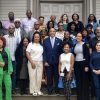The Alabama abortion ban has prompted new questions about why America’s elected officials don’t look more like America. Photograph: Natalie Behring/AFP/Getty Images
The US is becoming more diverse and progressive, but white men’s grip on power is being exercised via the courts, gerrymandering and dark money in politics
By Tom McCarthy, The Guardian —
The exercise of political power by legislative majorities of white, male elected officials in ways that disproportionately exclude or harm women and people of color is such a familiar part of the American political landscape that it sometimes goes underremarked.
That was not the case last week after 25 white Republican men in Alabama voted for a near-total abortion ban in the state, an act that focused the national attention and sparked fears of a broader assault on women’s rights.
But the furore around Alabama’s move was exceptional. Elsewhere white, male legislative majorities have enacted controversial policies without drawing such a spotlight, by stopping minimum wage increases, voting down paid sick leave, blocking bans on fracking, defeating gun safety measures, purging voter rolls, upholding discriminatory criminal justice measures and barring free choice in marriage.
Neither race nor gender nor any other demographic distinction is purely predictive of political outlook, and each of the causes listed above has had champions and opponents of all kinds.
But as when 11 white men on the Senate judiciary committee last year had to recruit a female lawyer to question Dr Christine Blasey Ford about her sexual assault claims against judge Brett Kavanaugh, the Alabama abortion ban has prompted new questions about why America’s elected officials don’t look more like America. It is also reinvigorating the debate about what that discrepancy is costing the country.
“It’s pretty clear that what’s happening in Alabama is not a reflection of what most people in Alabama want,” said Caroline Fredrickson, president of the American Constitution Society and former director of the ACLU’s Washington legislative office. “And so the ultimate question is: How is it happening that the state legislature is passing bills that the people don’t support?
A 2018 poll showed that the Alabama ban was supported by only 31% of people in the state.
“It is a reflection of a failure of democracy, of a democracy that has been hijacked by special interests, and in particular by white conservative men who have an agenda. It’s an economic agenda but it’s also a social agenda,” Fredrickson said.
The white male grip on political power in the United States is strong. Seven out of 10 US senators are white men, a group that makes up only about 30% of the US population. White men hold 65% of elected seats nationally, according to the Reflective Democracy Campaign. About half of all federal judges (but more than 70% of Donald Trump nominees) are white men.
The white male grip on power is also deeply entrenched, and well-insulated by historical design. It was written into the constitution, secured by the enslavement of African Americans and an economy and society built on slavery, and promulgated by generations of reinforcement and denial.
Many contemporary structures still prop it up. The US Senate, already badly underrepresentative, will become more so as city populations grow and rural populations shrink, swinging an even greater proportion of power to less populated, and more conservative, states. Federal courts have been rendered more conservative for at least a generation owing to a record number of lifetime appointments made by Trump. Voter suppression laws, dark money in politics and gerrymandering all reinforce a white male grip on power.
The proliferation of racially discriminatory voter suppression, half a century after the civil rights movement, is “shameful”, wrote Stacey Abrams, the former Georgia gubernatorial candidate and founder of the voting rights group Fair Fight Action, in a New York Times op-ed last week.
The impact of this dynamic on American life goes deeper, analysts say, than the fact that many citizens simply don’t see themselves in their elected representatives: white men are not creating the same America, through legislation, that a more representative group of lawmakers would.
The proportion of women serving in state legislatures stagnated for more than a decade around 25% in the lead-up to the 2018 election, said Jean Sinzdak, associate director of the Center for American Women and Politics at Rutgers University.
But when women are elected, they tend to advance a different agenda from men.
“There’s research that shows that female elected officials are more likely to make the governing process more transparent, they’re more likely to build consensus,” Sinzdak said. “They are also more likely to carry the water on issues like health and education. They’re more likely to bring previously marginalized groups into the policymaking process.”
The 2018 election saw a distinct uptick in the proportion of women in state legislatures, Sinzdak said, and the 2020 election could see the trend continue.
The current disproportionate representation in government of conservatives, in particular, has been achieved through a deliberate plan to seize the levers of power, Fredrickson explains in her recently published The Democracy Fix: How to Win the Fight for Fair Rules, Fair Courts and Fair Elections.
Progressives must mount a comparable effort in reply, Fredrickson says, describing part of the challenge as demanding that Democratic officials treat the confirmation of judges like the political process it is.
“We can’t complain about voting rights and gerrymandering and a whole set of other bad court decisions that are issued, and not actually have put in any energy to making sure that the courts are fair and representative,” Fredrickson said.
Another task is to confront voter suppression and the gerrymander, she said – and not in a way that simply results in a reciprocal Democratic gerrymander. An enforcement of “one person, one vote” and of fair districting benefits progressives “because progressives are the majority in this country,” she said.
“Because the country is becoming more and more demographically diverse and socially progressive, (fair districting) is actually going to produce outcomes that are more favorable to our values,” she said. “Which is why the right is fighting so hard against democracy in this country, because they know they’re outnumbered.”
The numbers only count when people show up to vote, and the men who enacted the Alabama abortion ban (and the woman governor who signed it) represent one of the country’s most reliable voting blocs: white evangelical Christians.
In his book The End of White Christian America, Robert P Jones, chief executive of the Public Religion Research Institute (PRRI), writes that the influence of white evangelical Christians in US politics is diminished, but persistent, owing to voter turnout patterns.
“White evangelicals over the last decade have dropped from about 21% of the population down to only 15% of the population, but both in the 2018 midterms and the 2016 election, they made up 26% of voters, according to the exit polls,” Jones told the Guardian. “And that’s because they turn out to vote at higher rates than nonwhite, non-Christian voters do. So basically they’re overrepresented at the ballot box.”
That could change with new voting patterns, Jones said. “If we ever got anywhere near parity of turnout, we’d see a dramatically different political landscape. At the end of the day, it really is about who shows up.”















